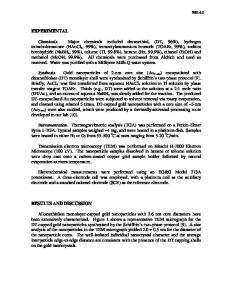Innovative gold nanoparticle patterning and selective metallization
- PDF / 209,844 Bytes
- 6 Pages / 432 x 648 pts Page_size
- 24 Downloads / 413 Views
Innovative gold nanoparticle patterning and selective metallization E.S. Kooij1, M.A. Raza1,2, H.J.W. Zandvliet1 1
Physics of Interfaces and Nanomaterials, MESA+ Institute for Nanotechnology, University of Twente, P.O. Box 217, 7500AE Enschede, The Netherlands 2
Centre of Excellence in Solid State Physics, University of the Punjab, QAC, Lahore-54590, Pakistan ABSTRACT We present a simple, novel procedure to selectively deposit gold nanoparticles using pure water. It enables patterning of nanoparticle monolayers with a remarkably high degree of selectivity on flat as well as microstructured oxide surfaces. We demonstrate that water molecules form a thin ‘capping’ layer on exposed thiol molecules within the mercaptan selfassembled layer. This reversible capping of water molecules locally ‘deactivates’ the thiol groups, therewith inhibiting the binding of metallic gold nanoparticles to these specific areas. In addition, we show that this amazing role of water molecules can be used to selectively metalize the patterned gold nanoparticle arrays. Employing an electroless seeded growth process, the isolated seeds are enlarged past the percolation threshold to deposit conducting metal layers. INTRODUCTION In the fabrication technology based on implementing functional nanoparticles, one of the key challenges is the patterned deposition of the nanoentities on pre-defined areas by simple, fast and low-cost methods. Various ‘top-down’ and ‘bottom-up’ techniques with sophisticated equipment and chemicals have been used to achieve the goal of nanoscale patterning. The majority of nano- and micropatterning techniques are in the former category, including photolithography, electron-beam lithography, microcontact printing, dip-pen nanolithography and laser-based patterning. Despite its enormous impact on modern technology, the top-down approach has a number of disadvantages and limitations. For example photolithography and electron-beam lithography techniques require hazardous chemicals. This in turn restricts their use in patterning nanoparticles or molecules with organic functionalities, because these chemicals may destroy the organic molecules and biological entities. Microcontact printing requires an elastomeric stamp to fabricate heterogeneous structures of typically micrometer dimensions, but use for a mixed functionality surface fabrication is limited [1]. In principle, dip-pen nanolithography enables nanoscale patterning [2]. However, due to the relativity low transfer efficiency the limited amount of materials transported to the substrate hinders large scale fabrication. Similarly, the laser-based patterning techniques such as laser-induced photothermal deposition [3] and laser-based particle deposition [4] can be used to pattern nanoparticles and nanoclusters, but again these technologies demand a sophisticated laser system and a complicated deposition process involving many steps. The alternative ‘bottom-up’ approaches resolve a number of drawbacks and limitations of the aforementioned methods. Moreover, various combina
Data Loading...











